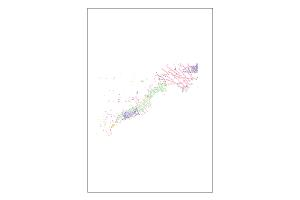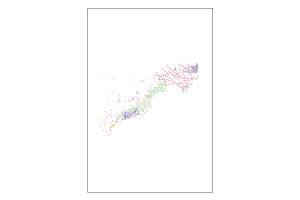gas
Type of resources
Keywords
Publication year
Service types
Topics
-
Australia has significant gas resources capable of meeting the needs of domestic and international consumers for decades. Commercial viability of the resource depends on a number of factors such as geology, infrastructure, resource quality, and water depth. Further exploration is required to bring on Australia's lowest cost gas resources.
-
Exploring for the Future Roadshow- Regional petroleum systems visualised in the EFTF Data Discovery Portal. A summary of petroleum systems of the Canning Basin and regional Meso- and Paleoproterozoic basins of northern Australia, and an introduction to the EFTF Data Discovery Portal
-
The Energy component of Geoscience Australia’s Exploring for the Future (EFTF) program is aimed at improving our understanding of the petroleum resource potential of northern Australia, including the Lawn Hill Platform region of the Isa Superbasin. The Paleoproterozoic Isa Superbasin in northwestern Queensland contains organic rich sedimentary units with the potential to host both conventional and unconventional petroleum systems (Gorton & Troup, 2018). On the Lawn Hill Platform, the River and Lawn supersequences of the Isa Superbasin host the recently discovered Egilabria shale gas play and are considered highly prospective shale gas targets. However, the lateral extent of these plays is currently unknown due to the limited well and associated geochemical data. To aid in the identification of new areas with the potential to host active petroleum systems, this work assesses the burial and thermal history of the Lawn Hill Platform (Figure 1) by using organic richness, quality and thermal maturity of source rocks of the Isa Superbasin. This assessment is based on a compilation of updated and quality controlled publicly available total organic carbon (TOC), Rock-Eval pyrolysis and organic matter reflectance data, and combines revised assessments of the depth structure and isopach mapping by Bradshaw et al., (2018, in press). Burial-thermal relationships in the basin have been difficult to determine in the past, usually attributed to multiple hydrothermal events which has resulted in erratic, and occasionally inverted, maturity reflectance profiles (Gorton and Troup, 2018; Glikson, 1993). Additional difficulties that contribute large uncertainties to our understanding are estimating the burial history across the basin, especially the maximum depth of burial and hence the estimated amount of erosion. Initial modelling suggests erosion amounts could range anywhere from several hundreds of meters to several thousands of meters across the Lawn Hill Platform region (Figure 2). Burial and thermal history modelling is calibrated using paleo-maturity data (reflectance profiles as mentioned above, Figure 2), which is poorly constrained. Because of the age (Paleoproterozoic) of the organic matter, reflectance values of alginite and bitumen were used, which are not always comparable to the standard vitrinite reflectance profiles that are typically used for burial and thermal history modelling calibration. In this study other options of burial-thermal model calibrations were assessed to aid in characterising the petroleum potential of this region, including; bottom hole temperature, developing an improved Tmax conversion equation specific to the Isa Superbasin region, using published conversion equations to convert alginite and bitumen reflectance to vitrinite equivalent reflectance, using HI as an indicator of thermal history, oxygen isotopes (δ18O), and fluid inclusion geothermometry. Abstract and poster for presentation at the Australian Organic Geochemistry Conference 2018
-
From the beginning of petroleum exploration in the Perth Basin, the importance of the Early Triassic marine Kockatea Shale was recognised as the principal source for liquid petroleum in the onshore northern Perth Basin (Powell and McKirdy, 1976). Thomas and Barber (2004) constrained the effective source rock to a Early Triassic, middle Sapropelic Interval in the Hovea Member of the lower Kockatea Shale. In addition, Jurassic and Permian sourced-oils (Summons et al., 1995) demonstrate local effective non-Kockatea source rocks. However, evidence for multiple effective gas source rocks is limited. This study utilizes the molecular composition and carbon and hydrogen isotopic compositions of 34 natural gases from the Perth Basin, extending the previous study (Boreham et al., 2001) to the offshore and includes hydrogen isotopes and gases. It shows the existence of Jurassic to Permain gas systems in the Perth Basin.
-
The Proterozoic succession in the NDI Carrara 1 drill hole, Northern Territory, consists predominantly of tight shales, siltstones, and calcareous clastic rocks. As part of Geoscience Australia’s Exploring for the Future program, this study aims to derive porosity, permeability and gas content from both laboratory testing and well log interpretation from machine learning approaches, to improve the Proterozoic shale gas reservoir characterisation. The Proterozoic Lawn Hill Formation was divided into four chemostratigraphic packages. The middle two packages were further divided into seven internal units according to principal component analysis and self-organising map clustering on well logs and inorganic geochemical properties. Artificial neural networks were then applied to interpret the mineral compositions, porosity and permeability from well logs, density and neutron-density crossplot interpretations. Gas content was estimated from the interpreted porosity, gas saturation, total organic carbon and clay contents. Petrophysical interpretation results are summarised for all chemostratigraphic packages and units. Package 2 (1116–1430.1 m) has the highest potential among the four chemostratigraphic packages. P2U1 (1116–1271 m) and P2U3 (1335.5–1430.1 m) units have the most favourable petrophysical properties for organic-rich shales with the average total gas contents of 1.25 cm3/g and 1.30 cm3/g, geometric mean permeability of 4.79 µD and 17.56 µD, and net shale thickness of 54.4 m and 85.3 m, respectively. P3U4 unit (687.9–697.9 m) has high gas content and permeability, with the net shale thickness of 29.1 m. Besides the organic-rich shales, the tight non-organic-rich siltstone and shale reservoirs in package 1 (below 1430.1 m) have average gas saturation of 14% and geometric mean permeability of 1.31 µD, respectively. Published in The APPEA Journal 2023. <b>Citation:</b> Wang Liuqi, Bailey Adam H. E., Grosjean Emmanuelle, Carson Chris, Carr Lidena K., Butcher Grace, Boreham Christopher J., Dewhurst Dave, Esteban Lionel, Southby Chris, Henson Paul A. (2023) Petrophysical interpretation and reservoir characterisation on Proterozoic shales in National Drilling Initiative Carrara 1, Northern Territory. <i>The APPEA Journal</i><b> 63</b>, 230-246. https://doi.org/10.1071/AJ22049
-

This is the Acreage Release Marine Environmental Data compiled web service to be updated each year with acreage release. It contains the following publicly available datasets, for the 2016 Acreage Release - Marine Survey Towed-video Transects, Marine Sediments Database Samples, Australian Seascapes, Seabed Mud Content on the Northwest Shelf, Seabed Sand Content of the Northwest Shelf and Seabed Gravel Content of the Northwest Shelf.
-

This is the Acreage Release Marine Environmental Data compiled web service to be updated each year with acreage release. It contains the following publicly available datasets, for the 2016 Acreage Release - Marine Survey Towed-video Transects, Marine Sediments Database Samples, Australian Seascapes, Seabed Mud Content on the Northwest Shelf, Seabed Sand Content of the Northwest Shelf and Seabed Gravel Content of the Northwest Shelf.
-
Animation demonstrating how fraccing is used in Coal Seam Gas (CSG) extraction.
-
Gas is a vital and growing part of the Australian and global energy mix. The gas industry is being transformed due to changes in markets and technology that are bringing new gas resources into play. This report builds on the Australian Energy Resource Assessment (AERA) was first published in March 2010 as a supporting document to the Energy White Paper process. The AERA (Geoscience Australia and ABARE, 2010) is a national prospectus for energy resources. It examined Australia's identified and potential energy resources ranging from fossil fuels and uranium to renewable sources. In the two years following the release of the AERA there have been significant changes in gas resources and within the gas market. This report provides an assessment of Australia's gas resources in 2012 and has been released to contribute to the final phase of the Energy White Paper process. The report documents the growth of gas resources and new projects that underpin an increasing role for gas both in Australia and internationally. For example coal seam gas (CSG) reserves have doubled since 2010 and three CSG/liquid natural gas (LNG) projects are now under construction, In addition, major new offshore conventional gas projects have been committed and commenced construction, including Ichthys in the Browse Basin and Prelude, the world's first floating LNG project. And Australia's third export LNG project, Pluto, has commenced operations.
-
Following the drilling of a shallow natural CO<sub>2</sub> reservoir at the Qinghai research site, west of Haidong, China, it was discovered that CO<sub>2</sub> was continuously leaking from the wellbore due to well-failure. The site has become a useful research facility in China for studying CO<sub>2</sub> leakage and monitoring technologies for application to geological storage sites of CO<sub>2</sub>. During an eight day period in 2014, soil gas and soil flux surveys were conducted to characterise the distribution, magnitude and likely source of the leaking CO<sub>2</sub> . Two different sampling patterns were utilised during soil flux surveys. A regular sampling grid was used to spatially map out the two high-flux zones which were located 20–50 m away from the wellhead. An irregular sampling grid, with higher sampling density in the high-flux zones, allowed for more accurate mapping of the leak distribution and estimation of total field emission rate using cubic interpolation. The total CO<sub>2</sub> emission rate for the site was estimated at 649-1015 kgCO<sub>2</sub>/d and there appeared to be some degree of spatial correlation between observed CO<sub>2</sub> fluxes and elevated surface H<sub>2</sub>O fluxes. Sixteen soil gas wells were installed across the field to test the real-time application of Romanak et al.’s (2012) process-based approach for soil gas measurements (using ratios of major soil gas components to identify the CO<sub>2</sub> source) using a portable multi-gas analyser. Results clearly identified CO<sub>2</sub> as being derived from one exogenous source, and are consistent with gas samples collected for laboratory analysis. Carbon-13 isotopes in the centre of each leak zone (−0.21‰ and −0.22‰) indicate the underlying CO<sub>2</sub> is likely sourced from the thermal decomposition of marine carbonates. Surface soil mineralisation (predominantly calcite) can be used to infer prior distribution of the CO<sub>2</sub> hotspots and as a consequence highlighted plume migration of 20m in 11 years. The broadening of the affected area beyond the wellbore at the Qinghai research site markedly increases the area that needs surveying at sufficient density to detect a leak. This challenges the role of soil gas and soil flux in a CCS monitoring and verification program for leak detection, suggesting that these techniques may be better applied for characterising the source and emission rate of a CO<sub>2</sub> leak, respectively. <b>Citation:</b> I.F. Schroder, H. Zhang, C. Zhang, A.J. Feitz, The role of soil flux and soil gas monitoring in the characterisation of a CO2 surface leak: A case study in Qinghai, China, International Journal of Greenhouse Gas Control, Volume 54, Part 1, 2016, Pages 84-95, ISSN 1750-5836, https://doi.org/10.1016/j.ijggc.2016.07.030.
